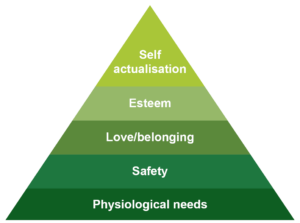Active Disengagement – The signs and consequences of severe employee disengagement
Here at The Survey Initiative, we often talk about the benefits of having engaged employees; How high engagement scores can have a multitude of benefits for the organisation, the managers, the team and of course the employee. But what about the other, less glamorous end of the spectrum? What are the key indicators and causes of active disengagement? And how can we prevent or address active disengagement within a team or organisation?

Active disengagement is defined by the Harvard Division of Continuing Education as the act of openly expressing dissatisfaction with one’s job and consistently voicing negativity towards it. An actively disengaged individual will often have higher rates of absenteeism, is more cynical and will exhibit a poor working attitude. Kahn (1990) stated that actively disengaged employees will detach themselves from their roles to the point that, when left unchecked, it will actually be destructive to the business. This kind of destructive behaviour is known as anti-organisational behaviour.
One example of how an employee might express active disengagement is malicious compliance. This (in a workplace capacity) is when an employee follows the rules set by a manager or company, even if they are aware that it may have a negative outcome. It has passive-aggressive undertones and is often the result of some form of employee disgruntlement and a dysfunctional relationship between an employee and manager. Malicious compliance within the workplace can be a very toxic and damaging behaviour for the harmony of a team. So how do we approach this from a management perspective? The answer is to look at this behaviour as the result of the working environment within a team and to delve into the working relationships within a team, as a group and as individuals.
So… What is causing disgruntlement to boil over into negative action? What is causing an employee to become actively disengaged to the point of passive aggression?
Lack of Consistency
One reason for this behaviour is that the policies and rules of the company are perceived by the employee to be inconsistent or unfair. The first thing to consider when implementing a new policy is ‘Is this a reasonable and effective policy?’ To help evaluate, consider a few things (according to the Society for Human Resource Management):
- Is there a need for this policy?
- Has the policy content been determined?
- Is the policy supported by our stakeholders? Are the senior members behind the policy?
- Has the policy been communicated effectively to employees?
- Can the employees have their say? Can the policy be updated or revised?
Lack of Trust in the Leadership
Having trust and confidence in the leadership and management of an organisation is pivotal to employee engagement; in fact, one of the pillars of engagement we use here at The Survey Initiative is Compelling Leadership. To not have trust is one issue, but to have active distrust the leadership is a very dangerous position to be in as an organisation. So what can cause mistrust in the leadership? In short, leadership and management need to be visible and accessible to their team/organisation. They must take time to meet and talk with their team regularly as this will help build meaningful relationships.
Lack of Opportunities for Career Progression and Personal Development
Another contributor to poor engagement levels is a lack of (or perceived lack of) career progression or personal development within the team and the organisation. If an employee feels that their career is at a dead end in the current situation, this will most likely lead to a lack of engagement and potentially cause the employee to look elsewhere for employment. If this feeling is prominent throughout the organisation this can lead to a high attrition rate, which will have a negative impact on the remaining workforce and could potentially a generate snowball effect of employees looking for employment elsewhere. Research carried out by SHRM (2008) found that of 3330 employees working at consulting firm Blessing White, nearly 1 third (29%) stated that a lack of career advancement would be their most likely influencer for them changing employers in the future.
Lack of Security
This one is a bit of an elephant in the room in the current climate. If an employee feels that their pay and benefits are inadequate, this can lead to disengagement, and if not addressed, active disengagement. The term ‘inadequate’ has a different meaning depending on the individual. For some employees ‘inadequate’ could mean that the pay isn’t enough to afford essentials. On the other end of the spectrum, are the more financially-driven employees, who may consider ‘inadequate’ as not enough for their ambitions.
However, we do have to be careful here…The link between pay and engagement levels is not as straight forward as you may think. Pay does need to be perceived as fair by the employee, but the drivers of long-term engagement tend to be more intrinsic than the salary, i.e., feeling like the communication is open and honest, having a sense of belonging within the organisation, and a genuine interest in the work. A pay rise or bonus may boost an employee’s motivation in the short term but unless an employee’s pay is having an impact on their livelihood (struggling to afford essentials), then engagement is, more often than not, driven by other factors. For example, how does the website Wikipedia continue to function? (stay with me…). Wikipedia has nothing to do with profit, yet is constantly kept running and up to date. This is due to people feeling passionately about a given subject matter, and so the reward for the hours they put into Wikipedia is not financial but for reasons of fulfilment. The intrinsic reward is a massively positive quality for an employee, and something to look out for as a manager when employees appear disengaged.
How do we, as managers, navigate disengagement brought on by pay-related issues? It is important to recognise that as an employer there is an element of responsibility for an employee’s financial wellbeing. CIPD (2023) site the 5 steps for developing an employee financial wellbeing policy:
- Build support and set strategic direction
- Assess and diagnose employee needs
- Actions and designs
- Implement and embed
- Evaluate and evolve
Approaching the issue
There is a wealth of research that has been carried out over the years on employee engagement and general employee psychology that points to the fact that active disengagement, and all the negative and toxic behaviours that come with it, come from a lack of something. This was highlighted by Macey & Schneider (2008), who noted that most existing conceptualisations of disengagement simply refer to an absence of and withdrawal of the cognitive, emotional, and physical self in the execution of both in, and extra, role behaviours.
So if you are seeing behaviours within your team such as malicious compliance, or any other behaviours that would suggest severe unrest and disengagement, we as managers should not jump to disciplinaries and confrontation, but first ask ourselves ‘do people have what they need to thrive within their role?’
Whether that be a lack of resources, training, understanding or lack of something on a more personal level. Looking at Maslow’s hierarchy of needs (1943) (which has been used as the go-to reference in terms of employee fulfilment and motivation – see below) we can look at each level and ask ourselves as managers “Are my employees being fulfilled at each of the levels within the hierarchy?”

https://www.shrm.org/hr-today/news/hr-news/pages/lackofcareeradvancement.aspx